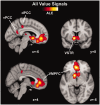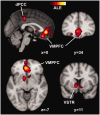Informatic parcellation of the network involved in the computation of subjective value
- PMID: 23887811
- PMCID: PMC4158359
- DOI: 10.1093/scan/nst106
Informatic parcellation of the network involved in the computation of subjective value
Abstract
Understanding how the brain computes value is a basic question in neuroscience. Although individual studies have driven this progress, meta-analyses provide an opportunity to test hypotheses that require large collections of data. We carry out a meta-analysis of a large set of functional magnetic resonance imaging studies of value computation to address several key questions. First, what is the full set of brain areas that reliably correlate with stimulus values when they need to be computed? Second, is this set of areas organized into dissociable functional networks? Third, is a distinct network of regions involved in the computation of stimulus values at decision and outcome? Finally, are different brain areas involved in the computation of stimulus values for different reward modalities? Our results demonstrate the centrality of ventromedial prefrontal cortex (VMPFC), ventral striatum and posterior cingulate cortex (PCC) in the computation of value across tasks, reward modalities and stages of the decision-making process. We also find evidence of distinct subnetworks of co-activation within VMPFC, one involving central VMPFC and dorsal PCC and another involving more anterior VMPFC, left angular gyrus and ventral PCC. Finally, we identify a posterior-to-anterior gradient of value representations corresponding to concrete-to-abstract rewards.
Keywords: IBMA; decision making; fMRI; meta-analysis; value.
© The Author (2013). Published by Oxford University Press. For Permissions, please email: journals.permissions@oup.com.
Figures








References
-
- Anderson AK, Christoff K, Stappen I, et al. Dissociated neural representations of intensity and valence in human olfaction. Nature Neuroscience. 2003;6:196–202. - PubMed
-
- Baumgartner T, Knoch D, Hotz P, Eisenegger C, Fehr E. Dorsolateral and ventromedial prefrontal cortex orchestrate normative choice. Nature Neuroscience. 2011;14:1468–74. - PubMed
Publication types
MeSH terms
Substances
Grants and funding
LinkOut - more resources
Full Text Sources
Other Literature Sources

